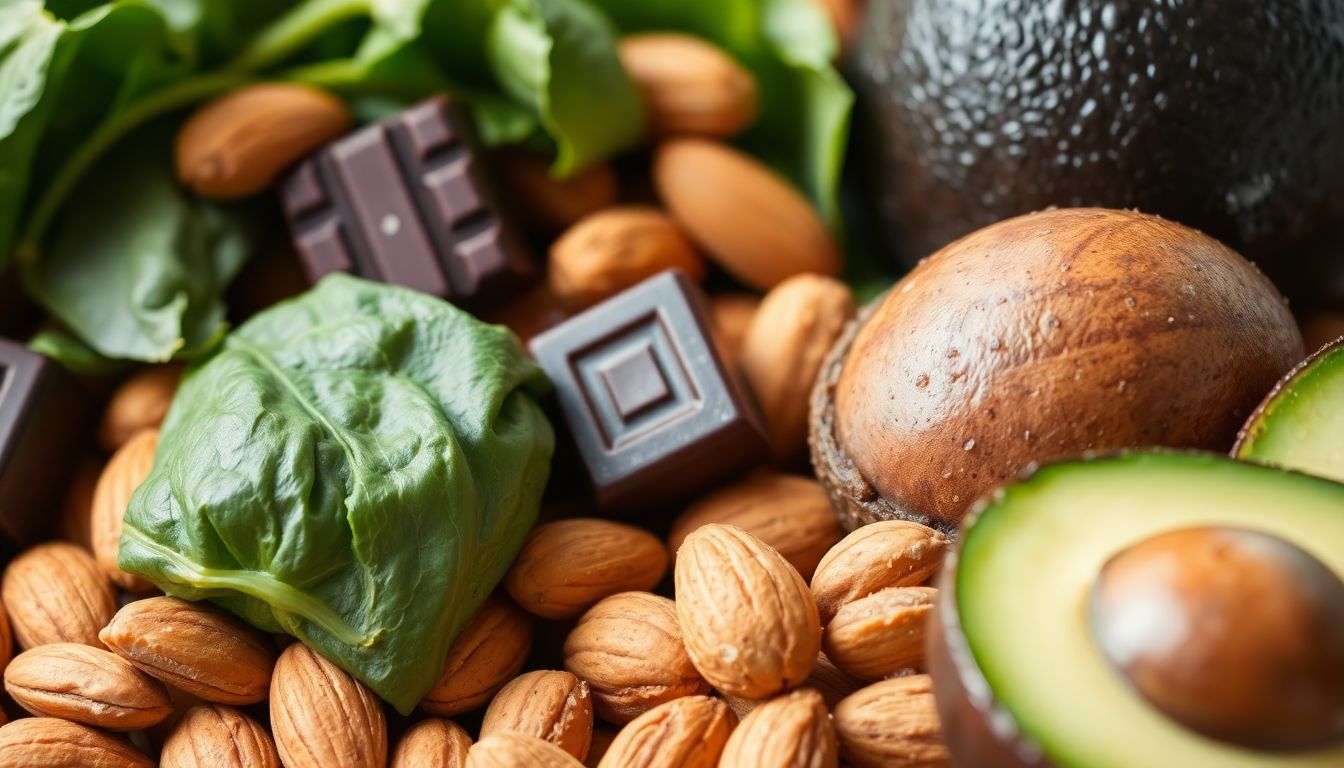 |
| Fuel your body with this yummy combination. |
Ever felt a muscle cramp out of nowhere? Or maybe you're just tired all the time? It could be a lack of magnesium. Magnesium is a big deal for your body. It helps with nerve and muscle function, blood sugar, and blood pressure. The good news is, plenty of foods pack this essential mineral. This guide will show you how to easily get more magnesium through what you eat!
Nuts and Seeds: Tiny Powerhouses of Magnesium
Nuts and seeds are great sources of magnesium. Eating them is also a really easy way to boost your health. They are full of nutrients beyond magnesium. You can add them to just about anything.
Almonds and Cashews: A Crunchy Delight
Almonds and cashews are easy to find and eat. A one-ounce serving of almonds gives you about 20% of your daily magnesium. Cashews aren't far behind, offering around 18%. These nuts also give you healthy fats and protein. They're great for a quick energy boost or a midday snack!
Pumpkin Seeds and Chia Seeds: Small but Mighty
Don't let their size fool you. Pumpkin and chia seeds contain a serious amount of magnesium. Just one ounce of pumpkin seeds offers a huge 37% of your daily magnesium. Chia seeds provide about 23% per ounce. Plus, they're packed with fiber and omega-3s. Sprinkle them on yogurt, salads, or smoothies for an extra boost.
Leafy Green Vegetables: A Nutritional Goldmine
Leafy greens are amazing for your health. They are low in calories but high in nutrients, including magnesium. So adding more green to your diet helps in many ways.
Spinach: Popeye's Secret Weapon
Popeye knew what he was doing! Spinach has a lot of magnesium. One cup of cooked spinach gives you about 39% of your daily magnesium. It also has a lot of vitamin A and iron. For best results, eat it cooked, which makes it easier for your body to absorb all the nutrients.
Kale: A Versatile Superfood
Kale is another leafy green that is full of magnesium. One cup of cooked kale has about 8% of your daily magnesium. It's not quite as much as spinach, but kale has other pluses. It's also packed with vitamins K and C. Try it in salads, smoothies, or baked into crispy chips.
Legumes: Plant-Based Protein and Magnesium
Legumes are an important part of a balanced diet. They are a great source of plant-based protein and magnesium. Eating them regularly can help you feel full and stay healthy.
Black Beans: A Southwestern Staple
Black beans are popular in Southwestern cooking. One cup of cooked black beans gives you about 15% of your daily magnesium. They're also full of fiber, which helps digestion. Try them in tacos, soups, or as a side dish. These little beans have been around for over 7,000 years!
Lentils: A Heart-Healthy Choice
Lentils are another great source of magnesium and protein. One cup of cooked lentils provides about 18% of your daily magnesium. They're also good for your heart. There are many kinds of lentils, like red, green, and brown. Each has its own special flavor and texture.
Whole Grains: Fueling Your Body with Magnesium
It's key to pick whole grains over refined ones. Whole grains keep all their nutrients. Refined grains lose some of them during processing. Whole grains have more magnesium.
Brown Rice: A Simple Side Dish
Brown rice is an easy way to add magnesium to your diet. One cup of cooked brown rice provides about 11% of your daily magnesium. It also has more fiber than white rice. Cook a big batch on Sunday. Use it in meals all week!
Quinoa: A Complete Protein Source
Quinoa is a great grain that is also a complete protein. One cup of cooked quinoa provides about 30% of your daily magnesium. It has all nine essential amino acids. It's a very versatile grain. Try it in salads, bowls, or as a side dish.
Dark Chocolate: Indulge Your Magnesium Craving
Here’s some great news, you can get magnesium from a tasty treat! But, it must be high-quality dark chocolate. Not the sugary kind.
The Magnesium and Antioxidant Connection
Dark chocolate can be a healthy way to get more magnesium. A one-ounce serving of 70-85% dark chocolate offers about 15% of your daily magnesium. Plus, it's packed with antioxidants. These protect your cells from damage.
Tips for Choosing the Right Dark Chocolate
When picking dark chocolate, read the label. Look for a high cocoa percentage. The higher the percentage, the more magnesium it has. Also, choose chocolates with less sugar and fewer additives.
Fatty Fish: A Source of Magnesium and Omega-3s
Fatty fish gives you a double dose of goodness. They are full of magnesium and omega-3 fatty acids. These acids are important for your heart and brain.
Salmon: A Heart-Healthy Choice
Salmon is great for your health and a good source of magnesium. A 3-ounce serving of cooked salmon provides about 6% of your daily magnesium. Plus, it's packed with omega-3s. When you can, choose sustainably sourced salmon for environmental reasons.
Mackerel: A Nutrient-Dense Option
Mackerel is another fatty fish that is high in nutrients. A 3-ounce serving provides about 19% of your daily magnesium. Mackerel has a distinct flavor. It works well grilled, baked, or smoked.
Conclusion
Magnesium is crucial for your health. Many foods have it. Nuts, seeds, leafy greens, legumes, whole grains, dark chocolate, and fatty fish can boost your intake. Try adding these foods to your daily meals! Remember to check with a doctor or dietitian for personalized advice.







0 Comments